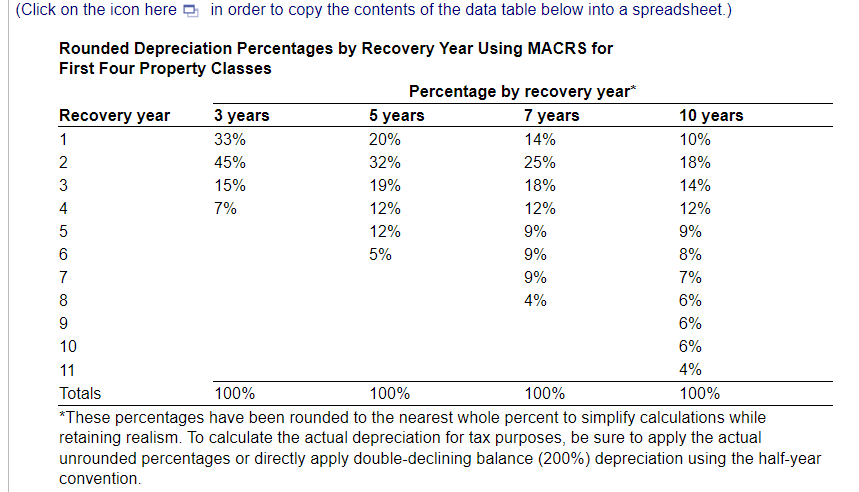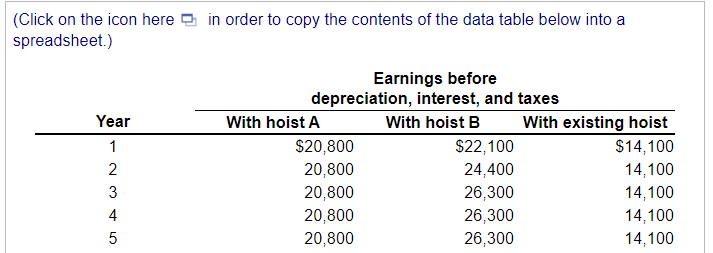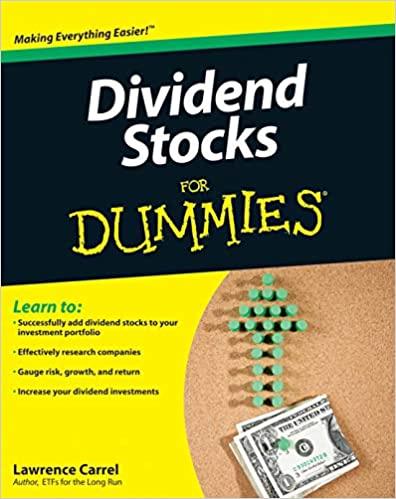


(Click on the icon here in order to copy the contents of the data table below into a spreadsheet.) Rounded Depreciation Percentages by Recovery Year Using MACRS for First Four Property Classes Percentage by recovery year* Recovery year 3 years 5 years 7 years 10 years 1 33% 20% 14% 10% 2 45% 32% 25% 18% 3 15% 19% 18% 14% 4 7% 12% 12% 12% 2% 9% 9% 6 5% 8% 7 9% 7% 8 4% 6% 9 6% 10 6% 11 4% Totals 100% 100% 100% 100% *These percentages have been rounded to the nearest whole percent to simplify calculations while retaining realism. To calculate the actual depreciation for tax purposes, be sure to apply the actual unrounded percentages or directly apply double-declining balance (200%) depreciation using the half-year convention 9% (Click on the icon here in order to copy the contents of the data table below into a spreadsheet.) Year 1 2 3 4 5 Earnings before depreciation, interest, and taxes With hoist A With hoist B With existing hoist $20,800 $22,100 $14,100 20,800 24,400 14,100 20,800 26,300 14,100 20,800 26,300 14,100 20,800 26,300 14,100 Integrative: Determining net cash flows Atlantic Drydock is replacing an existing hoist and is considering one of two newer, more efficient pieces of equipment. The existing hoist is 3 years old, cost $32,900, and is being depreciated under MACRS using a 5-year recovery period. Although the existing hoist has only 3 years (years 4, 5, and 6) of depreciation remaining under MACRS, it has a remaining usable life of 5 years. Hoist A, one of the two possible replacement hoists, costs $40,100 to purchase and $7,500 to install. It has a 5-year usable life and will be depreciated under MACRS using a 5-year recovery period. Hoist B costs $53,400 to purchase and $5,600 to install. It also has a 5-year usable life and will be depreciated under MACRS using a 5-year recovery period. Increased investments in net working capital will accompany the decision to acquire hoist A or hoist B. Purchase of hoist A would result in a $3,600 increase in net working capital; hoist B would result in a $6,500 increase in net working capital. The projected earnings before depreciation, interest, and taxes with each alternative hoist and the existing hoist are given in the following table : The existing hoist can currently be sold for $17,200 and will not incur any removal or cleanup costs. At the end of 5 years, the existing hoist can be sold to net $1,500 before taxes. Hoists A and B can be sold to net $12,200 and $21,000 before taxes, respectively, at the end of the 5-year period (see MACRS table B). The firm is subject to a 21% tax rate. a. Calculate the initial cash flow associated with each alternative. b. Calculate the periodic cash flows associated with each alternative. (Note: Be sure to consider the depreciation in year 6.) c. Calculate the terminal cash flow at the end of year 5 associated with each alternative. d. Depict on a time line the net cash flows associated with each alternative. (Click on the icon here in order to copy the contents of the data table below into a spreadsheet.) Rounded Depreciation Percentages by Recovery Year Using MACRS for First Four Property Classes Percentage by recovery year* Recovery year 3 years 5 years 7 years 10 years 1 33% 20% 14% 10% 2 45% 32% 25% 18% 3 15% 19% 18% 14% 4 7% 12% 12% 12% 2% 9% 9% 6 5% 8% 7 9% 7% 8 4% 6% 9 6% 10 6% 11 4% Totals 100% 100% 100% 100% *These percentages have been rounded to the nearest whole percent to simplify calculations while retaining realism. To calculate the actual depreciation for tax purposes, be sure to apply the actual unrounded percentages or directly apply double-declining balance (200%) depreciation using the half-year convention 9% (Click on the icon here in order to copy the contents of the data table below into a spreadsheet.) Year 1 2 3 4 5 Earnings before depreciation, interest, and taxes With hoist A With hoist B With existing hoist $20,800 $22,100 $14,100 20,800 24,400 14,100 20,800 26,300 14,100 20,800 26,300 14,100 20,800 26,300 14,100 Integrative: Determining net cash flows Atlantic Drydock is replacing an existing hoist and is considering one of two newer, more efficient pieces of equipment. The existing hoist is 3 years old, cost $32,900, and is being depreciated under MACRS using a 5-year recovery period. Although the existing hoist has only 3 years (years 4, 5, and 6) of depreciation remaining under MACRS, it has a remaining usable life of 5 years. Hoist A, one of the two possible replacement hoists, costs $40,100 to purchase and $7,500 to install. It has a 5-year usable life and will be depreciated under MACRS using a 5-year recovery period. Hoist B costs $53,400 to purchase and $5,600 to install. It also has a 5-year usable life and will be depreciated under MACRS using a 5-year recovery period. Increased investments in net working capital will accompany the decision to acquire hoist A or hoist B. Purchase of hoist A would result in a $3,600 increase in net working capital; hoist B would result in a $6,500 increase in net working capital. The projected earnings before depreciation, interest, and taxes with each alternative hoist and the existing hoist are given in the following table : The existing hoist can currently be sold for $17,200 and will not incur any removal or cleanup costs. At the end of 5 years, the existing hoist can be sold to net $1,500 before taxes. Hoists A and B can be sold to net $12,200 and $21,000 before taxes, respectively, at the end of the 5-year period (see MACRS table B). The firm is subject to a 21% tax rate. a. Calculate the initial cash flow associated with each alternative. b. Calculate the periodic cash flows associated with each alternative. (Note: Be sure to consider the depreciation in year 6.) c. Calculate the terminal cash flow at the end of year 5 associated with each alternative. d. Depict on a time line the net cash flows associated with each alternative









